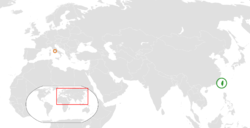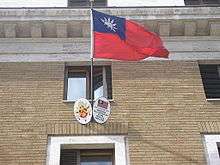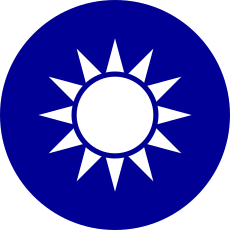Holy See–Taiwan relations
 |
|
Republic of China |
Vatican City |
|---|---|
Relations between the Holy See and the Republic of China were established on a non-diplomatic level in 1922, when Taiwan was not part of China (Taiwan was ruled by Japan from 1894 to 1945). In that year, Archbishop Celso Benigno Luigi Costantini was appointed to head an Apostolic Delegation in the country.[1][2] Though Archbishop Costantini did not have diplomatic status, the Chinese government gave him the same honours as those granted to the diplomatic corps accredited to China at the funeral of Sun Yat-sen in 1925.[3] Archbishop Costantini left China in 1933 and was succeeded by Archbishop Mario Zanin, who likewise was given all the honours reserved for Ministers Plenipotentiary.[4]
History
Agreement to establish diplomatic relations had been reached in 1917, but this move was blocked by France, which by the treaties imposed on China at the end of the Second Opium War held a "protectorate" over the Catholic missions in the country.[1][2][5]
Diplomatic relations were finally established on 23 October 1942[6] and, with the presentation by Archbishop Antonio Riberi of his letter of credence to the President in 1946, the Holy See's Apostolic Delegation in China gained diplomatic status.[7][8]
There was a period of confusion after the Republic of China government moved in 1949 to Taipei on the island of Taiwan, to which Japan had renounced all rights, title and claims four years before. Although many diplomatic missions followed the government to Taipei, the Holy See's mission remained on the mainland and sought contact with the new Communist regime, the People's Republic of China, which did not accept him as a diplomat and in 1951 expelled him (see the Death of Antonio Riva). In the following year, the Holy See, having been rejected by the Beijing government, resumed relations with the previous (Nationalist) government, which after its defeat on the mainland had moved to Taipei and continued to claim to represent all of China under the name of "Republic of China", as before.[9]
The United Nations continued to recognize the Taipei-based government as that of China until 25 October 1971. On that date, the seat of charter member of the United Nations and permanent member of the Security Council China passed to the Beijing government. The Holy See took account of the altered situation by moving to a new post the nuncio who had represented it in Taipei, and appointing no successor, so that its mission in Taipei has since then been headed only by a chargé d'affaires. The Taipei government has made no change in the status of the embassy to the Holy See that it maintains in Rome.
On April 8, 2005, President Chen Shui-bian represented "China" and attended the funeral of Pope John Paul II. In March 2013, President Ma Ying-jeou visited Vatican City to attend the inauguration of Pope Francis. However, no pope—even John Paul II, by far the most-traveled pope—has ever visited the areas controlled by the Taipei government.
As is usual for countries which maintain diplomatic relations with Taiwan, the Holy See in diplomacy recognises the Republic of China government as the government of China. As a result, when arranged alphabetically with other heads of state in Vatican ceremonies, ROC presidents are arranged under "Chine", French for "China" (French being the diplomatic language of the Holy See).
Gallery
 Like all other resident embassies to the Holy See, that of the Republic of China is located in Rome, outside of Vatican City, in a country with which the ROC has no diplomatic links
Like all other resident embassies to the Holy See, that of the Republic of China is located in Rome, outside of Vatican City, in a country with which the ROC has no diplomatic links
 At the funeral of Pope John Paul II, Chen (far left), seated as head of state in French alphabetical order (Chine immediately after Brésil) beside President Luiz Inácio Lula da Silva of Brazil and his wife
At the funeral of Pope John Paul II, Chen (far left), seated as head of state in French alphabetical order (Chine immediately after Brésil) beside President Luiz Inácio Lula da Silva of Brazil and his wife
See also
- List of Apostolic Nuncios to China
- Foreign relations of the Holy See
- Foreign relations of the Republic of China
- Roman Catholicism in China
- Chinese Catholic Bishops Conference
- China–Holy See relations
- Fu Jen Catholic University
- Republic of China Ambassador to Holy See
References
- 1 2 Beatrice Leung, Sino-Vatican Relations (Cambridge University Press 1992 ISBN 978-0-52138173-4), pp. 42–44
- 1 2 Nicolas Standaert, R. G. Tiedemann, Handbook of Christianity in China, vol. 2 (BRILL 2009 ISBN 9789004114302), pp. 564–565
- ↑ Landry Védrenne, "The Diplomatic Relations between the Holy See and the Republic of China from 1942 to 2012: History, Challenges, and Perspectives" (National Chengchi University, 2012), p. 36
- ↑ "China - from the Tablet Archive".
- ↑ Védrenne (2012), p. 32
- ↑ "Thanksgiving: 70th Anniv of Diplomatic Ties".
- ↑ Leung (1992), p. 44
- ↑ Védrenne (2012), p. 42
- ↑ China Church Quarterly, Fall 2008

